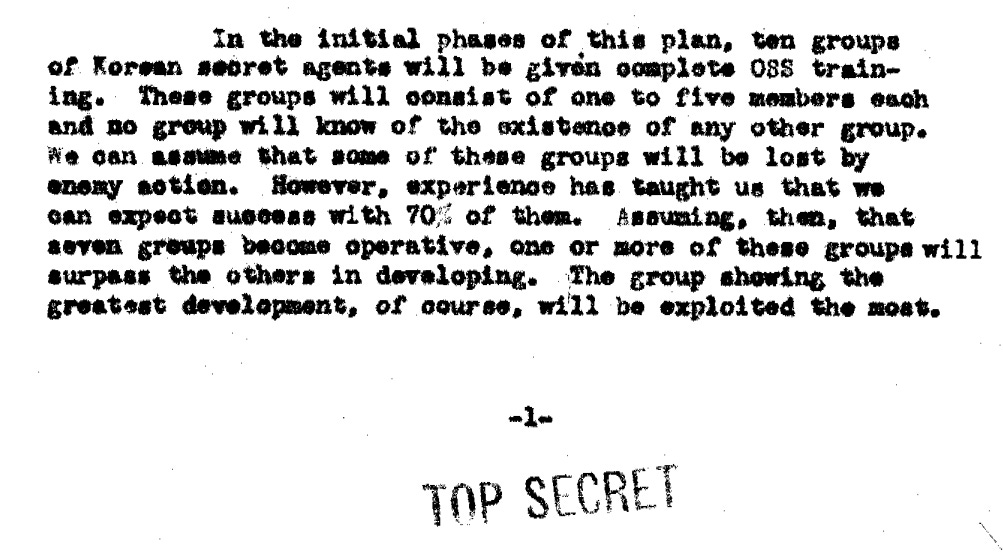In 2010, the CIA offered no objection to the full declassification of Carl Eifler’s plan for Project NAPKO, the daring scheme to infiltrate Korean agents into their homeland via small, submersible submarines.
In a word, the plan is strange.
Some sections are very detailed, others not so much.
For example, the plan calls for infiltration groups consisting of up to five agents. It provides detailed biographies of the group leaders, most of whom were in their forties. One was even in his fifties. None fit the bill as special forces soldiers or advanced covert operators.
The descriptions are relevant because the project, as described, was extremely physically demanding.
It was also dangerous.
The plan assumed up to a 30% loss rate on the 10 planned teams of agents.
No logical sense
The first prescribed move for the teams that made it ashore was to “contact underground members known to them.” Presumably, these networks were tied to the group leaders, some of whom were described as being academics and businesspeople.
However, some of the group leaders, not to mention the agent crew members, were supposedly prisoners of war.
The entire notion is, frankly speaking, ridiculous.
Supposedly, these soldiers hated the Japanese so much that while they served in the Japanese army as conscripts, they made contacts with the Korean underground. Then, when they were taken prisoner by the United States, the Korean soldiers were willing to volunteer for a dangerous mission as covert agents on behalf of the country with which they were at war. And this was all because of their hatred toward the ruling Japanese.
It just doesn’t add up.
Let’s take a step back, though, and focus on the first sentence of the paragraph in the image above:
In the initial phases of this plan, ten groups of Korean secret agents will be given complete OSS training.
The OSS conducted trainings varying in length from a couple weeks to around six months. It all depended on the type of students and the mission for which they were being trained.
We know that Moon Duck Harr and B. Hugh Tovar trained on Catalina Island at the same time as the Koreans who were part of project NAPKO.
Notably, Harr and Tovar received only a few weeks of training. As Tovar explained in an Oral History interview:
And let's see, then I was in the Army, you know, in the artillery for a couple years and then OSS reached out and grabbed me and brought me into the field there…They gave me a little more training and sent me off to China.
Eifler’s plan supports historical reports suggesting that two groups of Koreans trained at smaller training schools as part of Project NAPKO, while a secret group trained for a different mission at Toyon Bay.
Conclusion
The men who planned Project NAPKO, including Carl Eifler and his team, clearly took their orders seriously. No one writes 390 pages of Top Secret text as a diversion.
The slight of hand came from a higher level, where the narrative was formed and the history written.
There are numerous articles and books about Project NAPKO. Every one of them have papered over what was actually going on at Toyon Bay, where the main OSS training school on the island was located.
At this point, it is pretty clear that the secretive training performed over the course of a few weeks in the summer of 1945 at Toyon Bay was for Americans, not Koreans, and the mission was to China and Burma, not Korea.
Eifler’s plan states that the only reason that the main camp at Toyon Bay was not suitable to train the small Korean teams is that there was not enough space, and building the required additional quarters would have cost $800.
If the main training camp was short of space, we can conclude that a lot of agents were being trained there at the time in question.
Therefore, I suspect the secretive group of Korean agents training at Toyon Bay was, in reality, a group of Americans training to parachute into China and Burma.
We know that’s what Tovar did. More and more, it’s what I suspect Karl did, as well.
Eifler’s plan called for 450 U.S. Army personnel about one year into the project, which would have been the summer of 1945, just as Karl and Tovar were undergoing training.
Karl Harr and B. Hugh Tovar were both in the U.S. Army.
There must be something very sensitive about this mission for the CIA to keep it shrouded in mystery 80 years after the fact.
For now, though, I feel very comfortable concluding that Project NAPKO was just a cover operation.




